Beyond the Raw/Pasteurized divide
Thoughts on viewing the heating of milk as a spectrum of microbiological impacts.
There exists a tendency to see all dairy foods as being either raw or pasteurized. Like most dualistic concepts, this is a oversimplification, and there exists a rainbow between black and white. If we want to move beyond what is actually a legal definition, to understand how different ways of processing milk impact the microbiology and nutritional value of dairy foods, we need to transcend this dichotomy. Drawing hard lines and fighting over which side one is on, is the task of fools. There is hyperbole, ignorance, sectarian childishness, and misinformation from both Pasteurian proselytizers and raw milk renegades. I hope to show that there is a spectrum of levels of heating applied to milk that alter its microbiology in various ways. This microbiology is never static, and after the heating process, microbial communities continue to evolve and have new members join.
In most countries, milk needs to meet certain criteria and use state approved methods, tools, and materials to be considered pasteurized. Specific documentation is required for milk to meet this legal definition. Even if you heat milk to boiling, it is considered raw if the process doesn’t comply with the state mandates, often including a certified chart recorder that displays the time/temperature graphs used in many types of food processing. So rather than accept these legal definitions imposed by the state, I suggest we look at how different levels of heating affect the microbiology of milk, and attempt to create more accurate categories to encourage a more nuanced awareness.
There is a big difference between a raw lactic cheese in which the milk is generally never warmed above 32c (90F), A semi hard cheese cooked to 40c (104F), and something like an alpine or Grana cheese that is cooked to over 50c (122F) . The fact that any of these can labeled as raw milk cheeses shows the absurdity of the dicotomy. A third term is sometimes used that does help, by placing a 3rd marker on our spectrum. Under the definitions of the International Dairy Federation, raw milk is that which is never heated above 40c. Anything above that, but outside of the legal pasteurization requirements, is considered unpasteurized. 40c is not an arbitrary number. The growth of most Mesophillic Bacteria slow down significantly above 40c. And it is also at this temperature that Thermophiles are getting into the range at which they thrive.
If you search for information on the temperature ranges for meso and thermo bacteria you find a variety of answers. This indicates that there are grey areas, and differences between various species within these categories. But all Bacteria do have 4 phases corresponding with approximate temperatures.
1) Lag phase - when DNA is replicated, but there's no colony growth.
2) Log(exponential) - this is active colony growth. This is what we are really talking about when we use ranges, and of course the growth rate is not equal within the range, but has more of a bell curve with less rapid growth towards the extremes.
3) Stationary/maintenance - death rate equals multiplication rate.
4) Death - death rate exceeds multiplication rate.
There exists clusters of cheeses in certain temperatures ranges that have microbiological significance. These 3 categories are of course limiting, but they do correspond to important temperature ranges for bacterial growth. There are many outliers and no hard fast rules. Some soft cheeses are exposed to very high temperatures (mozzarella). Some fairly hard cheeses, like aged lactics, are never heated above meso range.
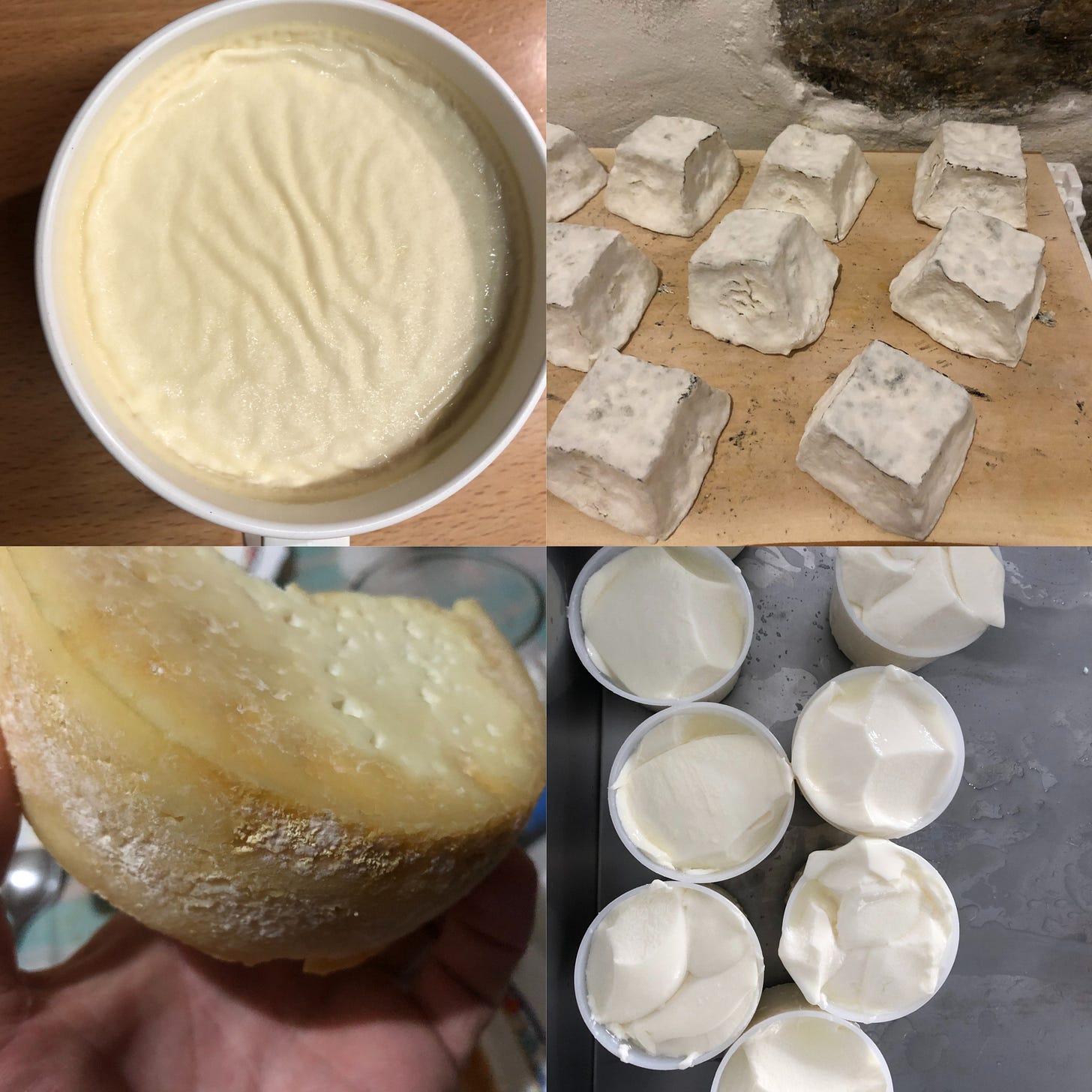
The first cluster is products in the mesophillic temperature range, between roughly 10 - 40c. This includes lactic cheeses, kefir, some meso “yogurts”, Bloomy rinds, most washed rinds, brine aged, and various soft cheeses. At times these are made with milk still warm from the animal, working with the freshest, sweetest milk with its raw milk ecology intact and beginning to flourish. There are many factors influencing this ecology which I will refrain from getting into further in this piece (teat treatment, animal bedding, milking equipment, climate, herd size and health, farming practices).
These ferments are utilizing predominantly mesophillic bacteria to ferment lactose into acids, often with yeast and other microbes also beginning to grow. They likely maintain the largest segment of the original raw milk microbial community, but since that ecology is always in flux, it’s hard to identify an “original community”. Once you begin fermenting milk and making cheese, certain members of the community are strengthened and grow exponentially, while others have their growth inhibited by the process. I believe you are always moving towards a smaller number of microbes dominating in this initial fermentation. Later, other players in the band raise their voices, and other microbes not originally found in the milk or starter cultures join the chorus.
Cluster 2: Meso/thermo contains cheeses that get close to or go slightly above the high end of meso range, but touch on a sweet spot where thermophiles are activated. It may be that Thermos are playing the primary role. Some say that mesos are killed by temperatures above 40c, but I doubt it is that simple. Many firm, semi firm, and semi soft cheeses reach this range, from cheddar and Tommes, to some washed rinds, and washed curd (Gouda). The fermentation is likely a mainly mesophillic driven one, but thermos can also play role, and will be important for the later ripening of the cheeses. This cluster has a tight range of about 38 - 42c (100- 107F). I am not sure how hard these lines are, or if meso are inactivated at a certain point or just slow way down. I am not a microbiologist, and this is conjecture, but it is a pattern I have noticed. This cluster fascinates me the most, as it is the overlapping, boundary zone between the other two, and can lead to some of my favorite flavor/textures.
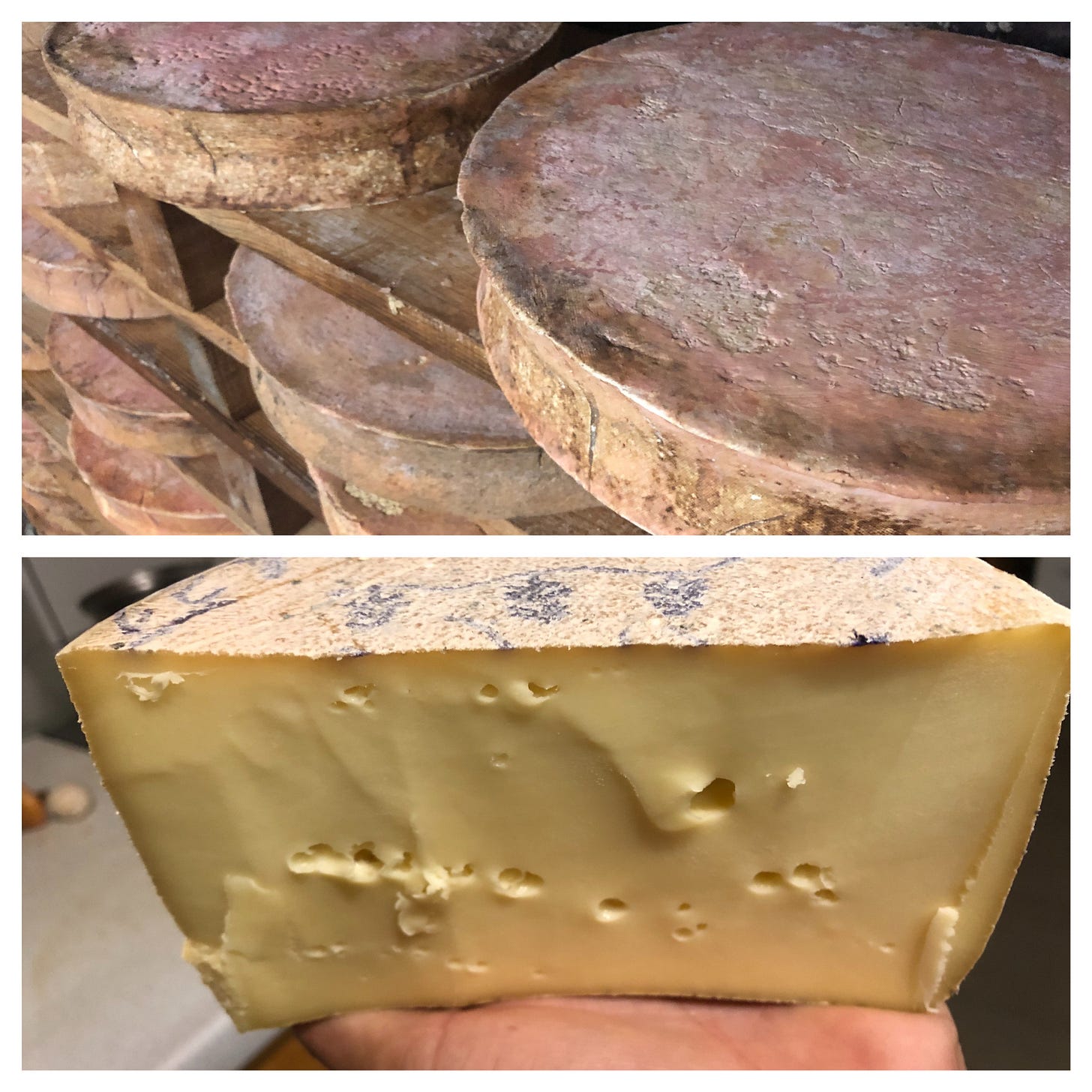
The 3rd cluster is what are known as thermophillic cheeses, those heated well above the meso range, whose fermentation is driven mainly by bacteria tolerant of high heat. The famous members are Alpines, and Grana (Parmigiano). Yogurt, and some other dairy foods fit in here. With these high heat products, many members of the community are inhibited and either die or slow way down in their growth. Cooking to these temperatures is a valuable strategy, as many potentially problematic microbes can be neutralized and prevented from spoiling cheese or creating undesirable traits. It allows for a predictable, consistent process, and should be considered a level of heat treatment.
Pasta filata, or stretched curd cheeses, show the weakness of my 3 clusters, and the raw/pasteurized divide. They may ferment at Meso or Thermo range, but then are exposed to water hotter than pasteurization temp. 80c seems to be normal, some use hotter. Does all of the curd mass reach this temp? Probably not. For how long? Not long. Does this kill off all bacteria? Probably not. But these cheeses are considered raw if made from milk that was not legally pasteurized. My whole point is that placing cheese into a binary definition denies the complexity of microbiology, of life. Maybe instead of trying to simplify everything and imposing a false sense of order on the world, we can embrace complexity and uncertainty, and humble ourselves in the process. While simultaneously seeking knowledge, quantifiable data, and learning from other ways of knowing, of working with microbes to preserve food.
An important caveat is that just because the milk used in cheese has selective pressures applied through heating, other members of the raw milk community can come back onto or into the cheese after it cools and is processed. So can microbes not originally found in raw milk, starter culture, or coagulant. I’ve seen many makers press with wooden equipment that had biofilms of yeasts, also airborn yeast and mold spores will land on cheese and begin growing. Coming out of brine and going onto aging boards, the succession of rind microbes begins its work. Cheese is never made in a sterile vacuum, and the move towards that fantasy is actually dangerous from the point of view of my vision of food safety.
Pasteurization is just one form of steering the microbial communities of raw milk. It is wrong to think it sterilizes the milk. Certain potential member of the community can survive, just in highly reduced numbers. Post pasteurization, microbes begin finding their way into milk, which is a perfect growth medium for microbial life. Milk will ferment, you can’t stop mother nature. Neither raw nor pastuerized milk are inherently safe to drink or necessarily free of pathogens. So let’s not get stuck in a simplified understanding that misses the point and uses the terms of the state to define our foods. We are better than that. Microbes, milk, and cheese deserve a more nuanced awareness.


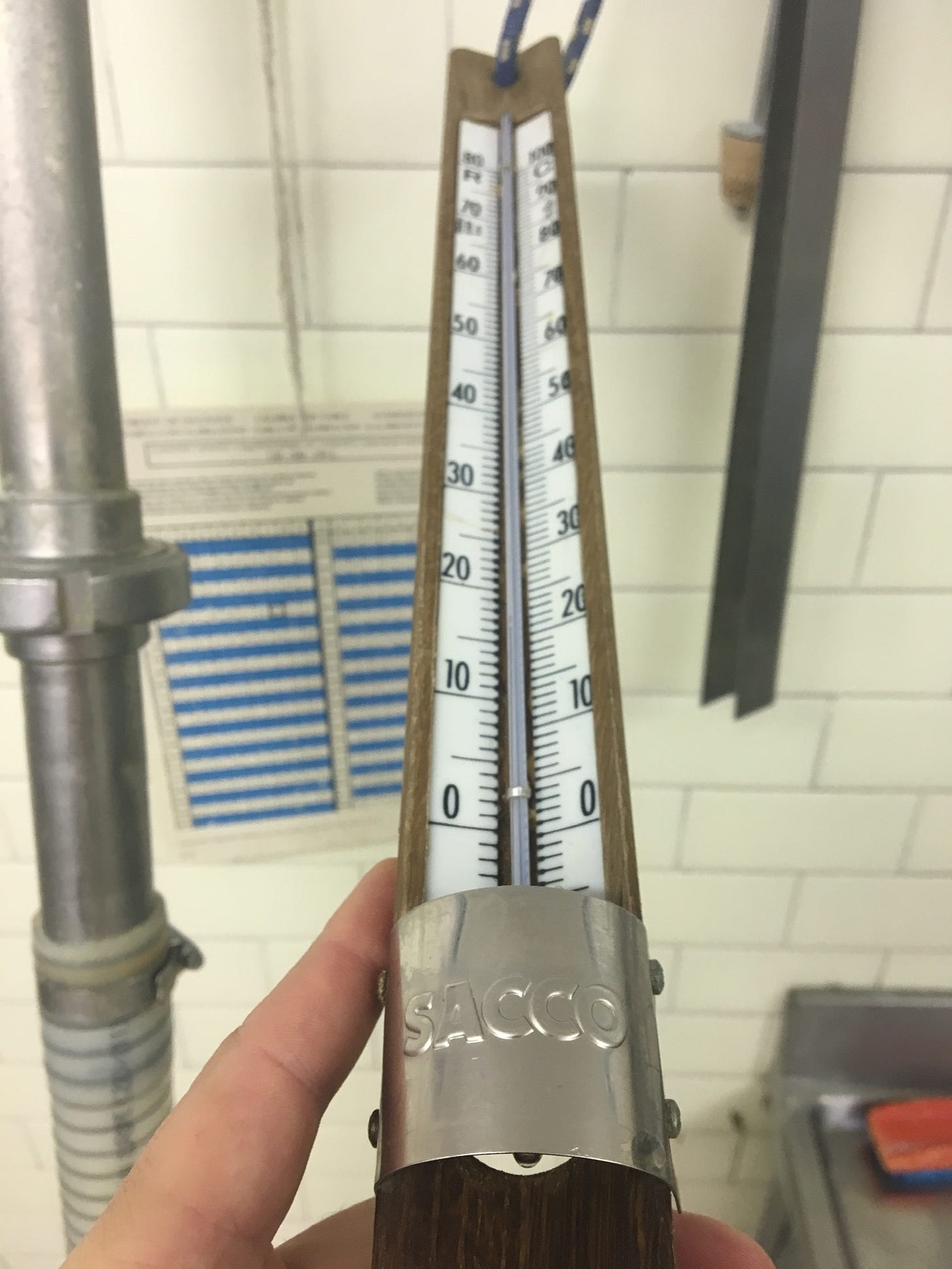
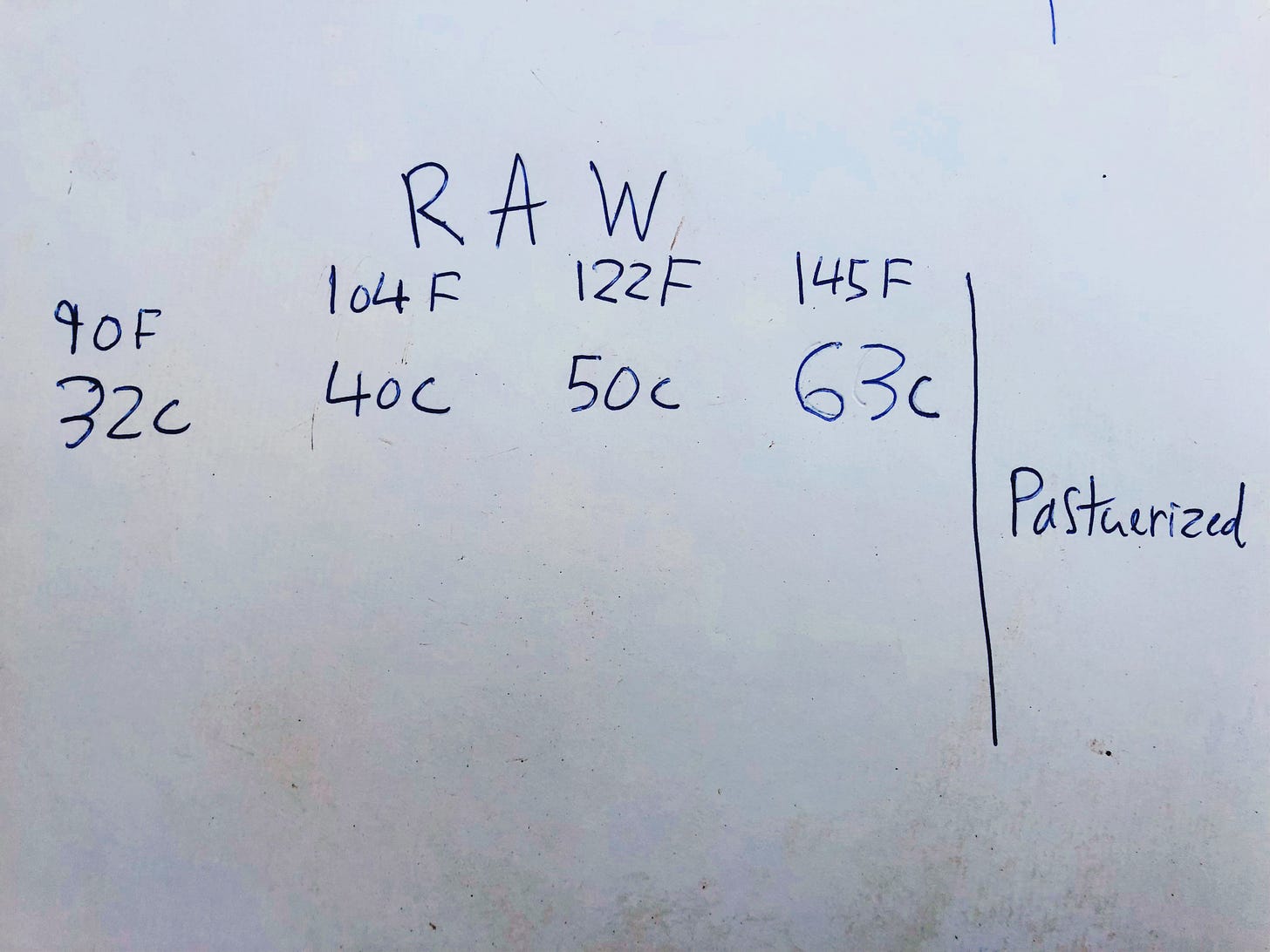
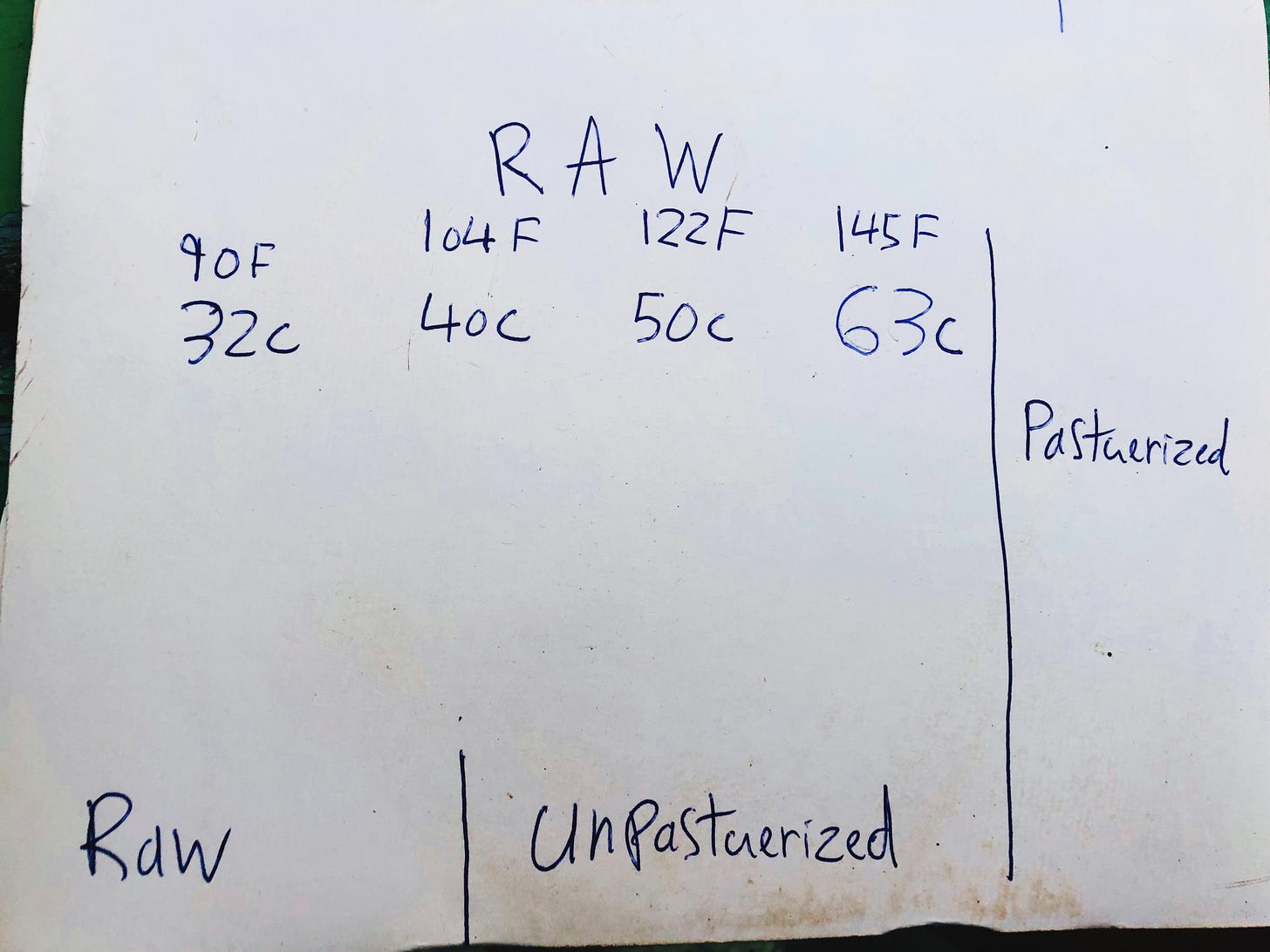
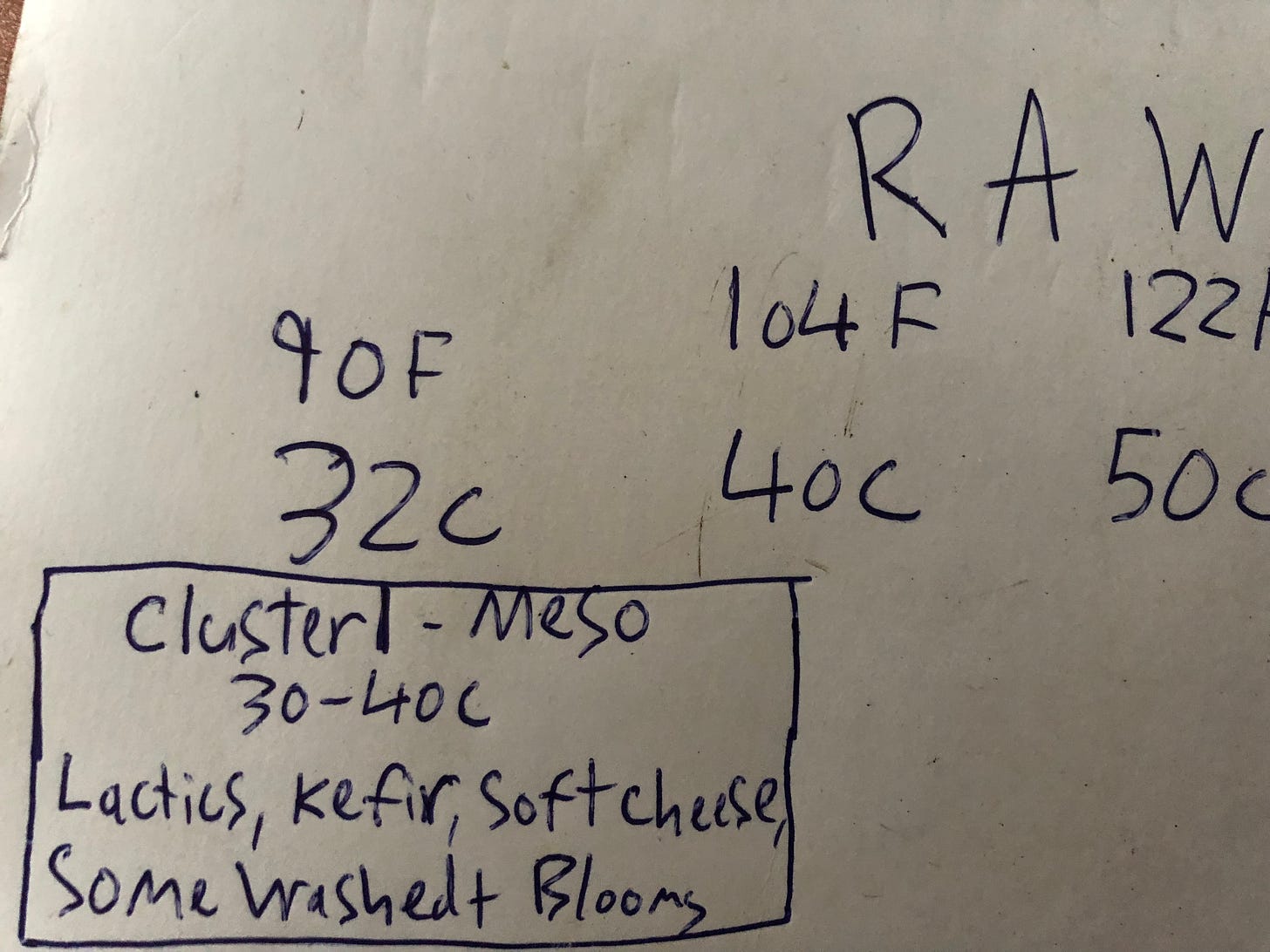
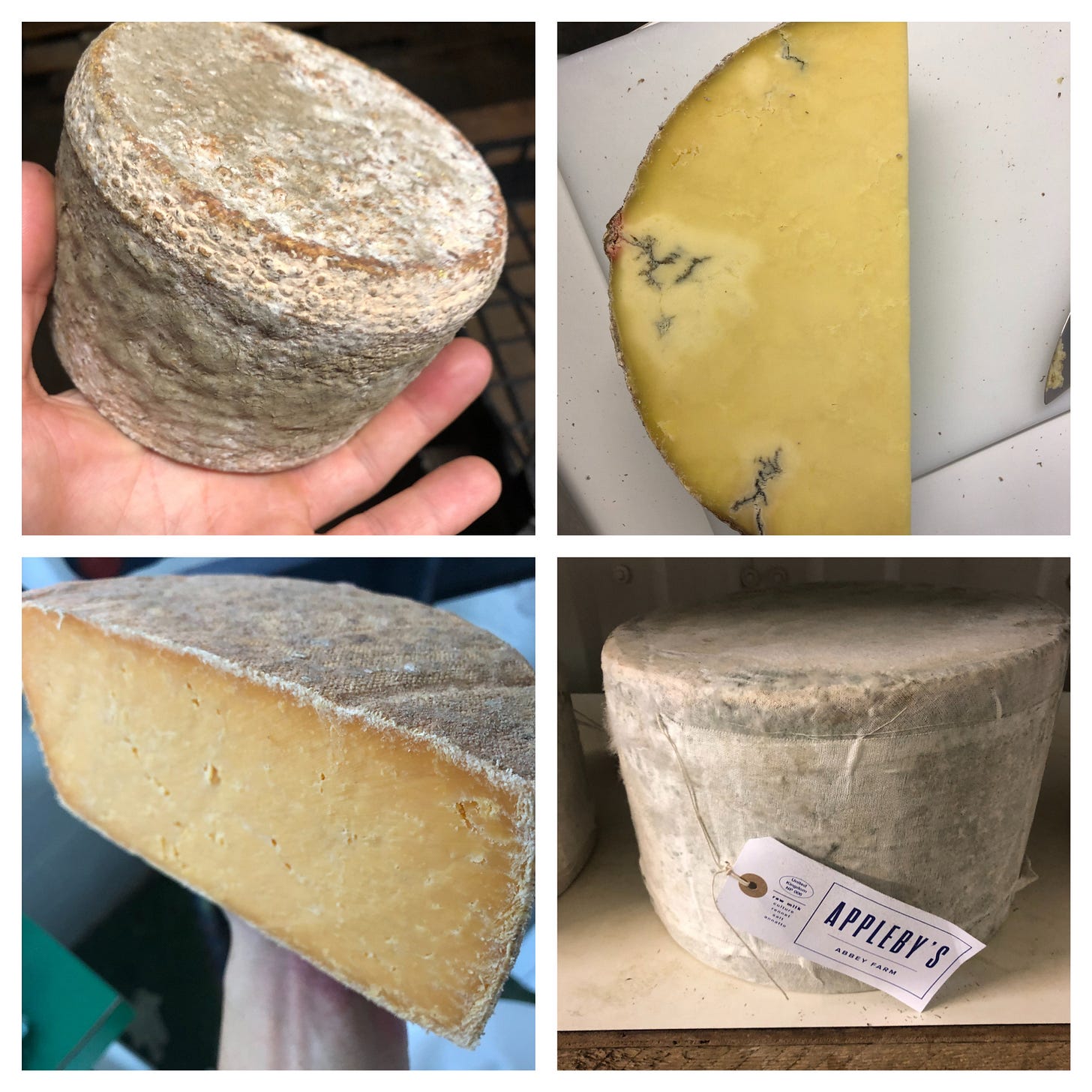

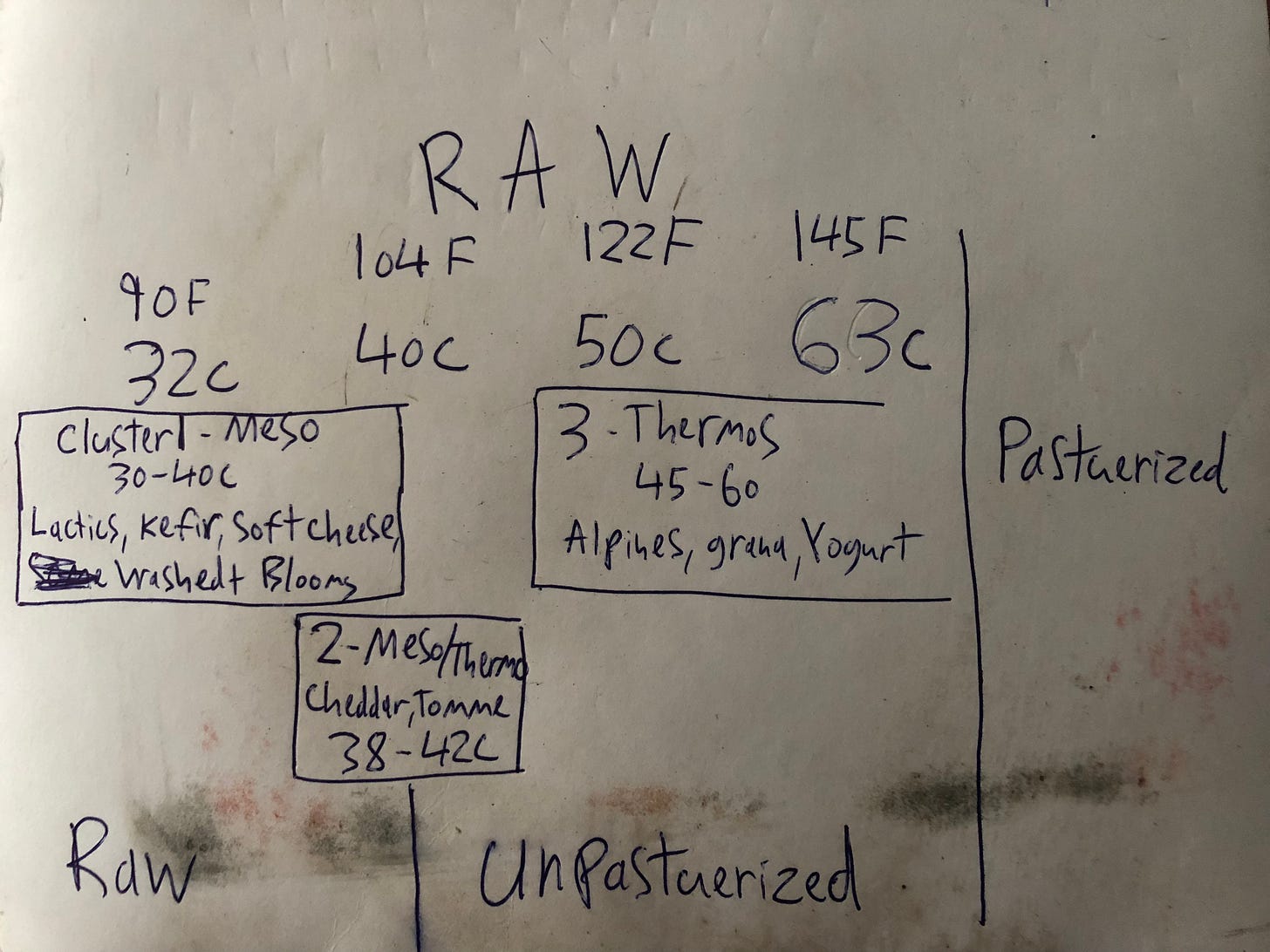
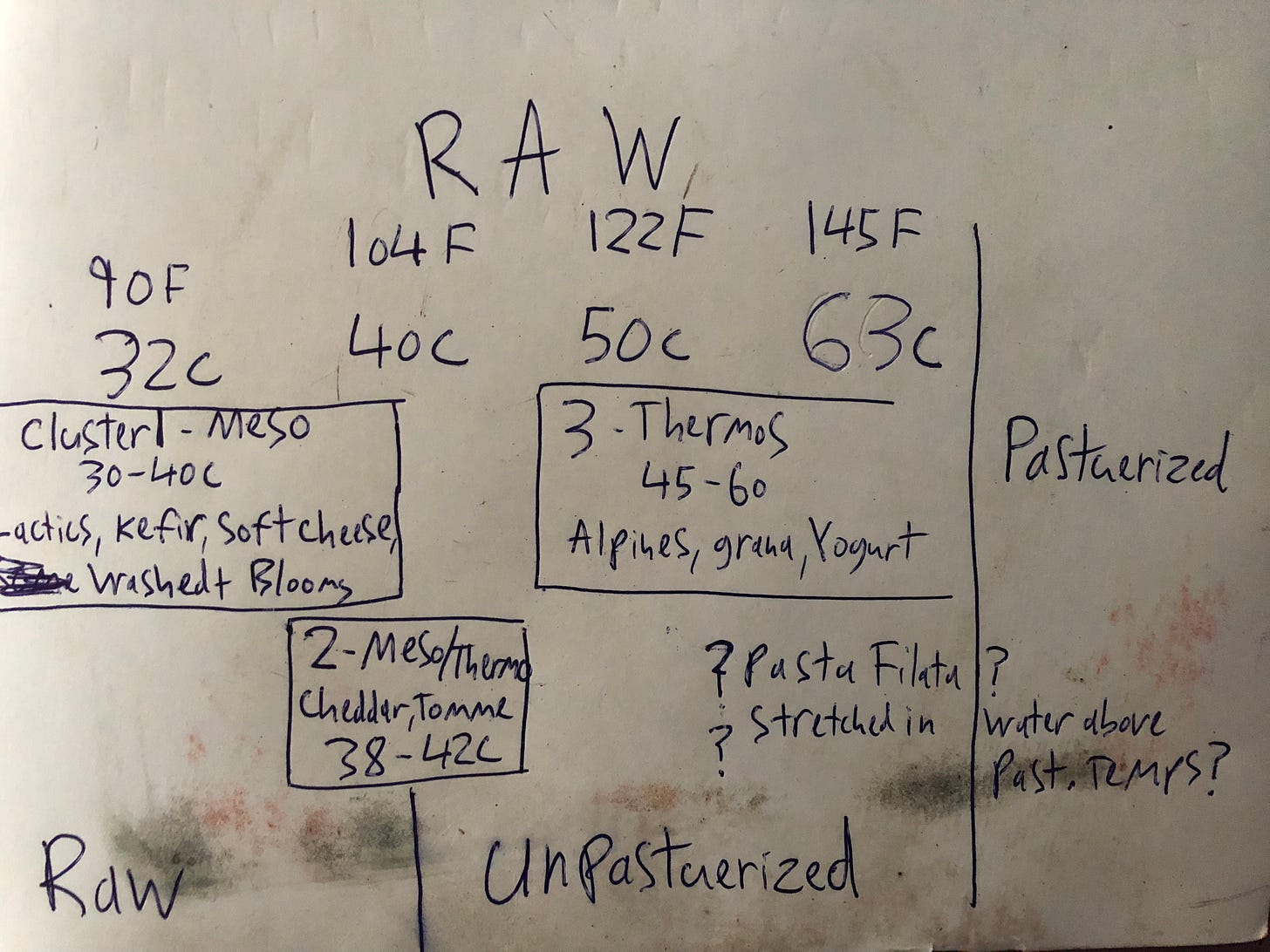
An insightful piece on what seems to be an unnecessarily divisive topic.
I am enjoying your thoughts, observations, travel and writing. I hadn't thought about raw milk, unpasteurized ( always wondered what that meant) and pasteurized as temperature spectrums other then the legal definition.
The clearer temperature ranges help mark these divisions. Also, Creating the happy habitat for our friends the bacteria hidden in each batch of milk and cheese.